INSTRUMENTATION AND CONTROL PRINCIPLES
Part -1:
LEARNING OUTCOMES
Knowledge and Understanding
Relate the performance of an instrumentation system to the properties and principles of operation of its subsections (transducer, signal conditioning/ conversion, output).
Cognitive & Intellectual Skills
Analyse instrumentation and control systems in terms of transfer function and response specifications and perform process loop tuning.
Key Transferable Skills
Apply mathematical skills in more complex contexts involving instrumentation and control.
Q1
(a) Explain the difference between a true zero signal and a live zero signal as applied to instrumentation.
(b) Give two advantages of a ‘live zero' system over that of a ‘true zero' system.
Q2 Give two advantages and two disadvantages of a closed-loop control system compared to that of an open-loop system.
Q3
a) Write down expressions for the open-loop, loop and closed-loop gains of the system shown in FIGURE 1 in terms of the stage gains A, B, C.
(b) The table below gives the magnitude and phase angle of the stage gains of the system represented by FIGURE 1.
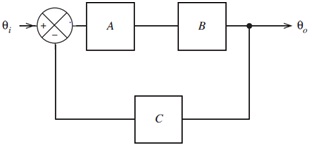
fig. 1
i) Determine if the system is stable.
ii) Determine the new value of controller gain that will cause the system output to oscillate with constant amplitude.
|
|
Magnitude of gain
|
Phase angle
|
|
Controller
|
A
|
0.5
|
13°
|
|
Process
|
B
|
2
|
113°
|
|
Measuring system
|
C
|
0.5
|
47°
|
Q4. Preamble: This question involves the use of an Excel spreadsheet [PID tuning] provided with the assignment on Blackboard.
The spreadsheet1 forms a PID Loop Simulator. From the screenshot below {Figure 2] it can be seen that spreadsheet simulates a process with a first order response that is modelled by entering values for its gain, time constant and delay (represented by the parameters K, T and L respectively).
The PID controller is set by entering values for its gain, integral and derivative settings (parameters C, I and D).
Provision is made for setting the Simulator to open-loop by entering a ‘0' in cell Q11 of the spreadsheet. A ‘1' entered in the cell gives the closed loop response.
Question
a) Figure 3 shows the open-loop response of a process modelled by the parameters K = 0.75, T= 50 s and L = 20s.
Determine suitable PID controller settings for the process using the ‘open-loop response' method.
Include in your answer a copy [screenshot] of the spreadsheet showing the response with you PID settings.
b) Use the simulation to find the correct PID settings of the controller by another tuning method.
Include in your answer a copy [screenshot] of the spreadsheet showing the response with you PID settings.
c) Compare the two methods of tuning used in (a) and (b) above in terms of ease of use, practicality and end result.
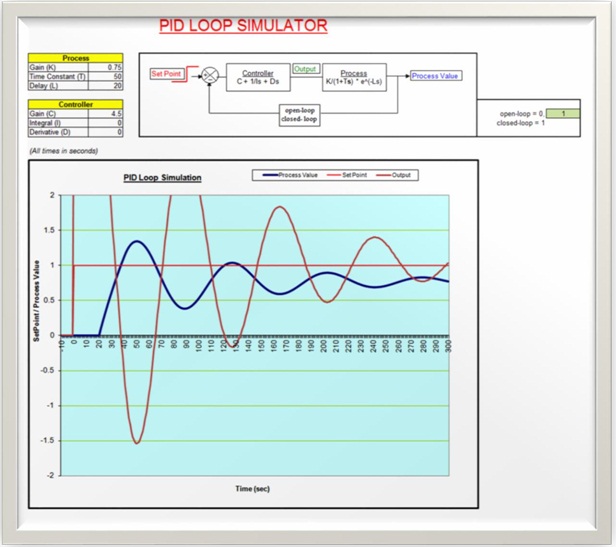
Fig 2
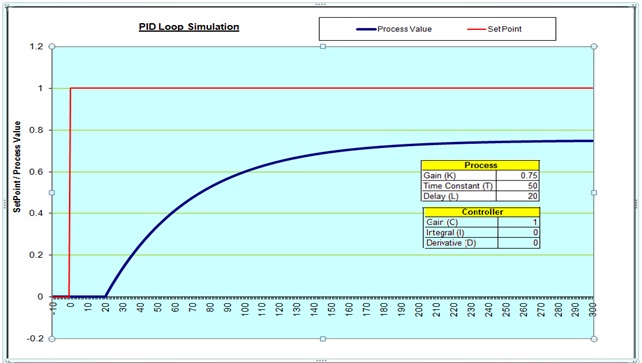
Fig 3
Part -2:
LEARNING OUTCOMES
Knowledge and Understanding
Relate the performance of an instrumentation system to the properties and principles of operation of its subsections (transducer, signal conditioning/ conversion, output).
Cognitive & Intellectual Skills
Analyse instrumentation and control systems in terms of transfer function and response specifications and perform process loop tuning.
Key Transferable Skills
Apply mathematical skills in more complex contexts involving instrumentation and control.
Q1 a) Identify the type of valve shown in FIGURE 1 and give its application.

fig. 1
b) The gas phosphine (PH3) is widely used in the semiconductor industry for the doping of silicon wafers. In a particular manufacturing process a diaphragm cut-off valve is used in the pipeline supplying phosphine gas from a supply tank to the equipment.
Explain briefly why a diaphragm valve has been chosen for this application
Q2. As an engineer in a chemical factory you are required to choose the type and size of control valve to be used in the system shown below, FIGURE 2. A pump is used to pass a chemical through a heat exchanger and then on to a reactor. The valve is used to throttle the pipe line connecting the heat exchanger to the reactor.
The sizing of the valve is important as the chemical is part of a sensitive reaction and inaccurate additions will ruin the entire batch.
The liquid chemical, which has a density of 600 kg/m3, is pumped at 5.5 bar gauge at a nominal rate of 16 litres per second. However the design must permit the flow rate to vary over the range of 8 to 25 litres per second. The design must also allow for a pressure loss of 0.7 bar across the heat exchanger and the pressure in the reactor must be kept at 2.1 bar. It can be assumed that the flow is turbulent and non-choked.
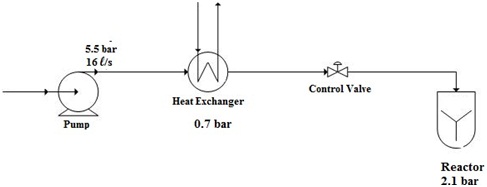
fig. 2
a) Select, giving your reasons, the type of valve you would recommend from:
Ball Butterfly Plug Globe
b) Suppose the valve you have chosen has the size-KV values shown in the table below.
i) Use the table to determine the required valve size for a nominal flow of 16 litres per second.
ii) Check to see if this valve size is suitable over the range of the full flow-rate {8 to 25 litres per second} and amend your sizing if necessary.
|
|
Kv as a %age of valve travel
|
|
Valve
|
10%
|
25%
|
50%
|
75%
|
100%
|
|
½"
|
0.03
|
0.075
|
0.3
|
0.5
|
1
|
|
½"
|
0.05
|
0.12
|
0.48
|
0.8
|
1.6
|
|
½"
|
0.08
|
0.19
|
0.75
|
1.25
|
2.5
|
|
½"
|
0.13
|
0.3
|
1.2
|
2
|
4
|
|
¾"
|
0.21
|
0.47
|
1.89
|
3.15
|
6.3
|
|
1"
|
0.33
|
0.75
|
3
|
5
|
10
|
|
1¼"
|
0.53
|
1.2
|
4.8
|
8
|
16
|
|
1½"
|
0.83
|
1.88
|
7.5
|
12.5
|
25
|
|
2"
|
1.33
|
3
|
12
|
20
|
40
|
|
2½"
|
2.10
|
4.73
|
18.9
|
31.5
|
63
|
|
3"
|
3.33
|
7.5
|
30
|
50
|
100
|
|
4"
|
5.33
|
12
|
48
|
80
|
160
|
|
5"
|
8.33
|
18.75
|
75
|
125
|
250
|
|
6"
|
13.33
|
30
|
120
|
200
|
400
|
3a) Identify the type of control valve trims shown in FIGURE 3 and give an application for each.
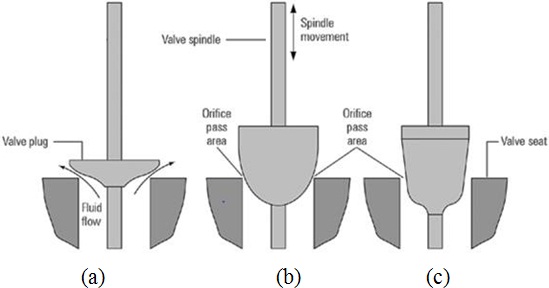
fig. 3
b) The maximum flowrate through a control valve with an equal percentage characteristic is 10 m3/h. If the valve has a rangeability ratio of 50:1 and is subjected to a constant differential pressure, calculate the percentage change in flowrate through the valve for valve lifts at 10% intervals.
Hence show that the valve is indeed equal percentage by finding the change in flowrate from one interval to the next.
[n.b. a spreadsheet would be a useful tool to use in this question!]
Q4. a) Explain the meaning of the terms ‘choked flow' in relation the flow of gas through a valve. Explain also how choked flow for a gas differs from choked flow for a liquid.
b) Calculate the equivalent choked flow of propane through a particular valve if the choked flow of natural gas through it is 10 litres s-1.
The relative density* of propane is 1.45 and that natural gas is 0.65. [*with reference to air]
c) A valve is required to regulate the flow of natural gas. Details of the gas are given in table below. It can be assumed that the pipe size and the valve size are the same [i.e. piping geometry does not have to be allowed for].
The chosen valve type is the V250 rotary ball valve by Fisher Controls International [the V250 data sheet is available on Blackboard].
- Determine the required valve size in inches from the range of sizes given in the data sheet [the data sheet gives a range of nominal pipe sizes (NPS) in inches].
- Estimate the percentage the chosen valve would have to be open to carry the required flow.
|
Natural Gas
|
|
|
Required volumetric flow rate [@ STP]
|
2.8 x 106 litre per minute
|
|
Density [@ STP]
|
0.752 kg per m3
|
|
Specific heat ratio
|
1.31
|
|
Inlet pressure
|
20 bar gauge
|
|
Outlet pressure
|
6 bar gauge
|
|
Inlet Temperature
|
20 °C
|